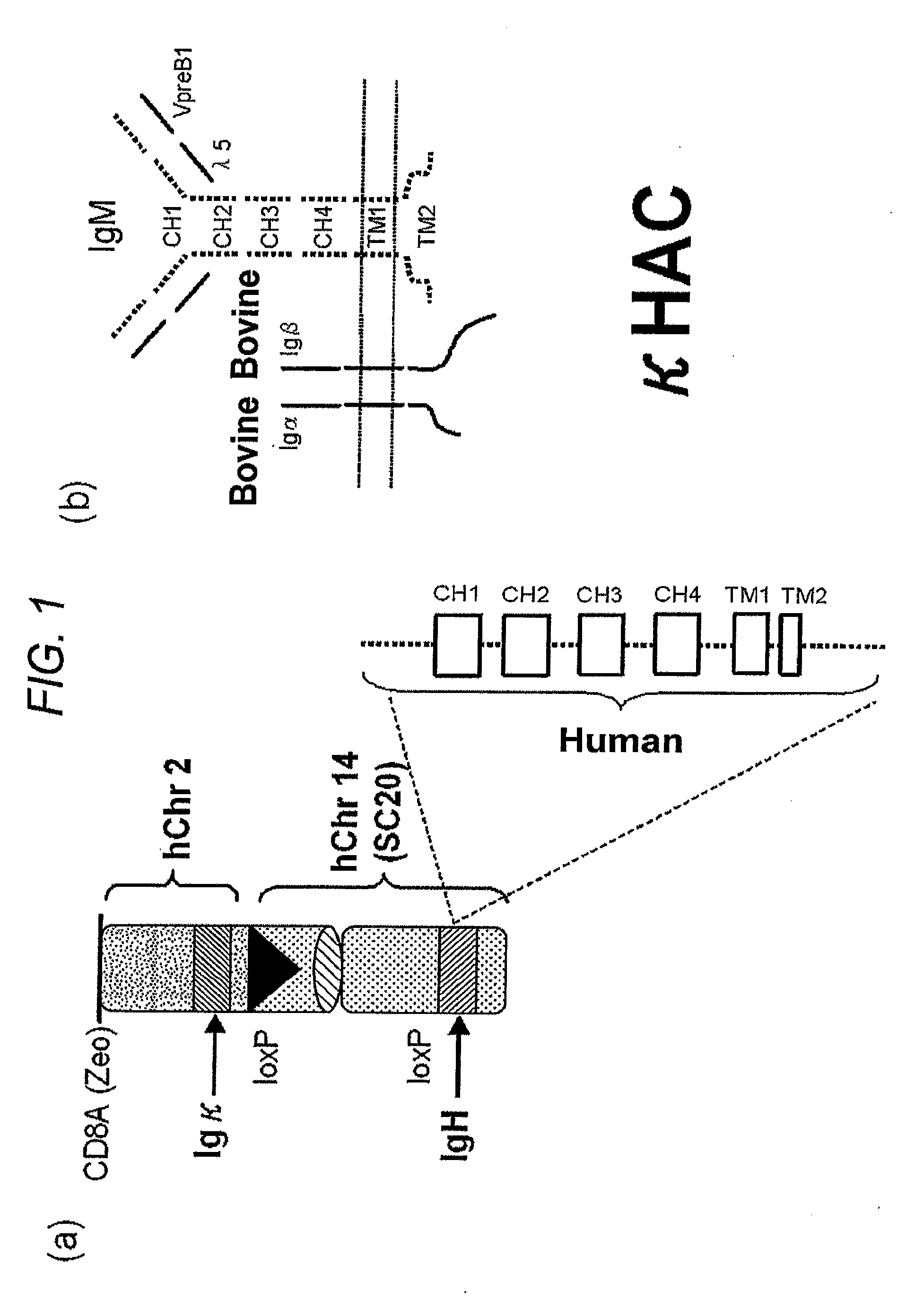Human artificial chromosome vector
a technology of artificial chromosomes and vectors, applied in the field of human artificial chromosome vectors, can solve the problems of limited development of the use of them, and achieve the effects of high efficiency, stably produced, and high efficiency
- Summary
- Abstract
- Description
- Claims
- Application Information
AI Technical Summary
Benefits of technology
Problems solved by technology
Method used
Image
Examples
example
Example 1
Construction of a Targeting Vector
[0167](1) Construction of a Targeting Vector pTEL'hisDpurolox2272F9R9
[0168]Methods described in the publication (Kuroiwa et al., Nat Biotechnol. 18: 1086-1090, 2000, Kuroiwa et al., Nat Biotechnol. 20: 889-894, 2002 and Kuroiwa et al., Nat Biotechnol. 27: 173-181, 2009) were basically used for construction of a targeting vector.
[0169]Specifically, a genomic DNA fragment Dk-F9R9 used as a homology arm was amplified by PCR consisting of 40 cycles of 98° C. for 10 seconds and 68° C. for 9 minutes by using two primer DNAs of kD-F9 (5′-tcgaggatccgccagggagacagatgccaagtacggtttag-3′) (SEQ ID NO:1) and kD-R9 (5′-tcgaggatccaggatctttgggggactgaatggggtgtgct-3′) (SEQ ID NO:2) and a genomic DNA of a chicken DT40 cell line KTL1 (Kuroiwa et al., Nat. Biotechnol. 27: 173-181, 2009) having the human chromosome 2 as a template.
[0170]Subsequently, the plasmid pTEL'hisDpurolox2272 was constructed in the following order.
[0171]First, the plasmid pPURlox2272 was co...
example 2
Construction of KSL-HAC
[0210](1) Modification of the Human Chromosome 2 in a Chicken DT40 Cell
[0211]In order to generate a deletion at the AP104134 site of the human chromosome 2 and insert a lox2272 sequence and a promoterless puror cassette, the targeting vector pTEL'hisDpurolox2272F9R9 was linearized with SrfI (Stratagene) and introduced into KTL1 (Kuroiwa et al., Nat. Biotechnol. 27: 173-181, 2009) which was a chicken DT40 cell line having the human chromosome 2 fragment digested at the CD8A gene locus by electroporation (550 V, 25 μF). The electroporation of the DT40 cell was carried out by a method described in the publication (Kuroiwa et al., Nat. Biotechnol. 18: 1086-1090, 2000).
[0212]Colonies were subjected to selection by histidinol (0.5 mg / ml, Sigma) for two weeks and the sensitivity to puromycin (1 μg / ml, Sigma) was measured as an index of deletion of the puror cassette on the CD8A gene locus.
[0213]The chromosome DNA was extracted from a colony having the puromycin sensi...
example 3
Construction of KSL-HACΔ
[0259](1) Modification of the Human Chromosome 14 in a DT40 Cell
[0260]In order to integrate a lox511 sequence and a CAG promoter on the AL512355 site which is positioned on the centromere side about 300 kb from the IgH gene locus, the targeting vector pSC355CAGlox511hisDDT linearized with SrfI (Stratagene) was introduced into the DT40 cell maintaining an intact human chromosome 14 labeled with pSTneo [Katoh et al., Cell Structure and Function, 12, 575-580, 1987; Japanese Collection of Research Biologicals (JCRB) Bank, Deposit Number VE039] by electroporation (550 V, 25 μF). The electroporation method into the DT40 cell is described in the publication (Kuroiwa et al., Nat. Biotechnol. 18: 1086-1090, 2000).
[0261]The colony was subjected to selection by histidinol (0.5 mg / ml, Sigma) for two weeks, and thus a genomic DNA extracted from the resistant colony was subjected to PCR screening.
[0262]PCR was carried out with 40 cycles of 98° C. for 10 seconds and 68° C. ...
PUM
| Property | Measurement | Unit |
|---|---|---|
| concentration | aaaaa | aaaaa |
| humidity | aaaaa | aaaaa |
| temperature | aaaaa | aaaaa |
Abstract
Description
Claims
Application Information
 Login to View More
Login to View More - R&D
- Intellectual Property
- Life Sciences
- Materials
- Tech Scout
- Unparalleled Data Quality
- Higher Quality Content
- 60% Fewer Hallucinations
Browse by: Latest US Patents, China's latest patents, Technical Efficacy Thesaurus, Application Domain, Technology Topic, Popular Technical Reports.
© 2025 PatSnap. All rights reserved.Legal|Privacy policy|Modern Slavery Act Transparency Statement|Sitemap|About US| Contact US: help@patsnap.com



